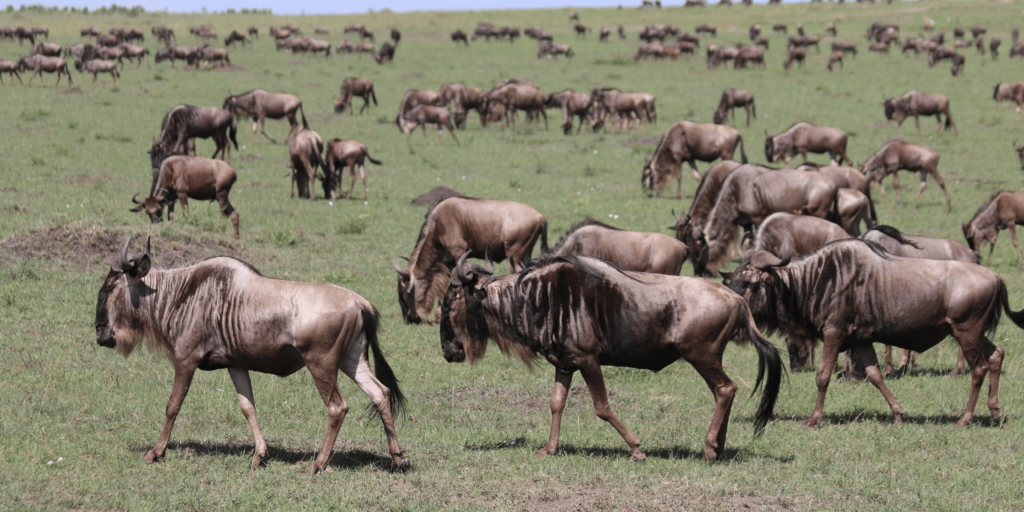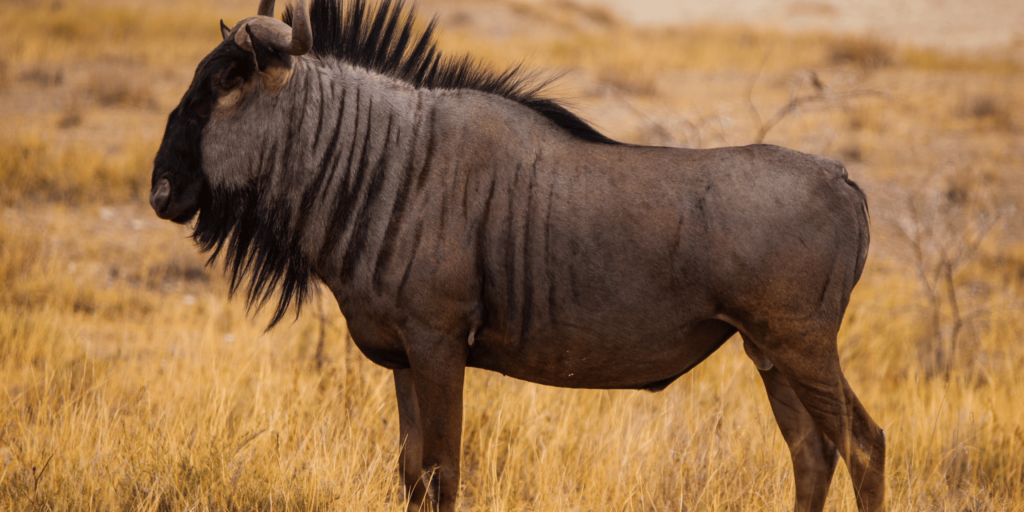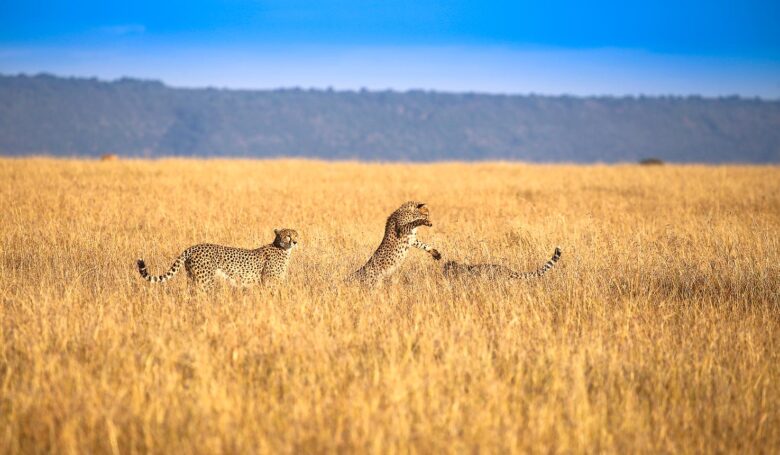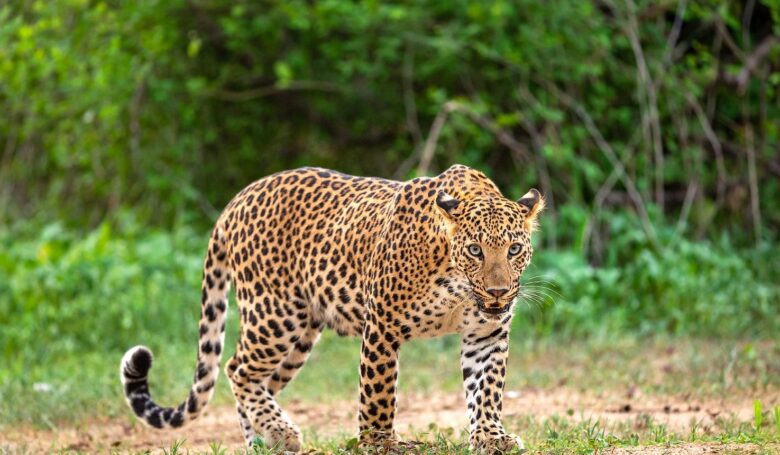The Great Wildebeest Migration, experienced during a Kenyan safari, is an unforgettable sensory experience that captivates visitors with the majesty of nature. This migration is the largest herd movement of animals on the planet, with densities reaching up to 1,000 animals per square kilometre. The numbers are astonishing: over 1.2 million wildebeest and 300,000 zebras, along with topi and other gazelles, move in a constant cycle through the Serengeti-Mara ecosystem in search of nutritious grass and water. Guided by their survival instincts, each wildebeest will cover between 800 to 1,000 kilometres along ancient migration routes. Hungry predators such as lions, leopards, cheetahs, hyenas, wild dogs, and crocodiles ensure that only the strongest animals survive in this natural spectacle, often referred to as “the greatest show on Earth.”
This remarkable scene showcases the savannah, filled with galloping wildebeests moving in unison alongside zebras and gazelles, vividly portraying the wilderness. As these animals traverse the landscape in search of greener grass, the powerful movements and sounds they create resonate deeply, allowing us to visualize the scene in our minds. This natural cycle invites us to pause and appreciate the wondrous, inspiring, and enchanting aspects of instinct and the individual’s will to survive.
The wonder of observing this awe-inspiring yet terrifying natural phenomenon allows visitors to witness both the raw strength and beauty of nature. The movement of tens of thousands of wildebeest, along with zebras and gazelles, creates a striking visual and auditory experience that captivates the senses. As you watch these animals traverse the landscape in search of fresh pastures, it tugs at your heartstrings. Their instincts and natural navigation skills are on full display. The experience profoundly impacts your soul, leaving an unforgettable mark on everyone fortunate enough to witness it.
What is the Great Wildebeest Migration
The Great Wildebeest Migration in Africa, also known as the Gnu Migration, Serengeti Migration, and Masai Mara Migration, is one of the largest mass terrestrial wildlife movements remaining on the planet. This incredible event is the primary reason many travellers visit Kenya and Tanzania for a migration safari, particularly around mid-year.
Migration is one of nature’s greatest paradoxes: timing is crucial, yet there is no way to predict when animals will move. We know that wildebeest, along with a few zebras and antelopes, will cross the Mara River, but no one can pinpoint the exact moment. Additionally, we understand that rainfall prompts the wildebeest to seek fresh grazing areas, but the timing of the rain remains uncertain.

The circuit begins in the Ngorongoro Conservation Area, located south of the Serengeti in Tanzania, and extends through the Serengeti National Park, crossing into the Masai Mara in Kenya before returning. This journey is fraught with dangers: young calves are often taken by predators, the slower animals are hunted by prides of lions, and some brave individuals may suffer injuries from steep riverbanks. Crocodiles seize their opportunity to catch stragglers, while the weak and exhausted may drown.
Choosing the Right Time to Spot the Migration
Deciding the best time to spot the wildebeest migration on your Kenyan Safari is just as crucial as any issue that concerns the presence of the Wildebeest. Understanding seasonal trends and the behaviour of wildebeest can significantly enhance your chances of experiencing a great migration. This migration typically occurs between July and October, as the herds travel long distances in search of greener pastures. Planning your safari during this time increases your likelihood of witnessing this incredible phenomenon. However, it’s important to note that the exact timing of the migration can vary from year to year. Therefore, consulting with wildlife experts or checking seasonal reports can be invaluable for ensuring a memorable safari experience.
The schedule is one of the biggest components of the planning process when visiting the Wildebeest’s migration on the Kenya Masai Mara safari. Recognizing seasonal motions and displacements of the wildebeest population is important to increase the chances of witnessing this kind of natural parade. Predominantly from July to October, their nowadays annual trail starts from the lower altitudes and continues until they reach some higher, greener pastures. Scheduling your safari during this period of the year ensures a high probability that you and your company will be graced with the privilege of witnessing this spectacular sight. On the other side, it is crucial to remember that some timescales might vary each year, so professional safari operators or wildlife experts are recommended for you to get maximum exposure to the wonder of that African safari discovery.
Need help planning a safari to spot the migration? Feel free to contact us
Planning Your Kenya Masai Mara Safari
With the Kenya Masai Mara safari package to watch The Great Migration of Wildebeest, preparation is very important to enable you to have an excellent experience. After considering a few tourist operators and specialized tour guides who have a high knowledge of animal behaviour and migration patterns, you will most probably be able to see the spectacle. Apart from this, we need to take into account other issues like accommodation choices, transport alternatives, and journey routes that will provide bountiful and meaningful safari experiences. During that period from July to October, if you set your travel plan during this time, you will have more chances to experience the migratory pattern behaviour of the animals and power.
By beginning the challenging task of viewing the Wildebeest Great Migration on Kenya Masai Mara safari with good preparation and foolproof plan-making of the key factors, you will be able to accomplish your objective in the best way ever. Booking travel through reliable and well-informed tour companies, as well as safari guides who are good at wildlife behaviours, will ensure you have a pleasant experience. Similarly, height enables the scenery of accommodation, transport, and route proximity, which will eventually guarantee a smooth and pleasurable safari tour. It would be advantageous to synchronize the dates of your visit with the peak flow season that takes place between July and October, and thus, the probability of viewing this stunning show with your own eyes would grow in the process.
Experiencing the Great Migration Firsthand
Experiencing the Great Wildebeest Migration on a safari in Kenya is nothing short of the adventure of a lifetime. Witnessing thousands of wildebeests, accompanied by zebras and gazelles, traversing the savannah grasslands creates a sensory experience that words simply cannot capture. At home, these animals are domesticated and aware of their feeding schedules, but in the wild, the sight of them in their natural habitat is awe-inspiring and unforgettable. This powerful connection to wildlife compels nature enthusiasts and wildlife lovers alike, all driven by a strong desire to immerse themselves in the beauty of the natural world.
This is an adventure that brings the amazing world of nature very close to the minds of the visitors. The unbelievable sea of thousands of wildebeest busily migrating past and mixed with herds of zebras and gazelles is a visual tsunami that is difficult to describe in words. Migrating across the country, these animals portray how they instinctively behave to search for better pastures. It is a life at risk for each one of them, but this is where survival instincts come into play. The space alone of this unforgettable show is in the minds of all those who have the opportunity to see it close-up, and this cannot be understated for both nature and wildlife lovers.
Book our 3-day Luxury Masai Mara Safari
Conservation and Ethical Considerations
The best way to prepare for the mesmerizing safari of the Kenyan Masai Mara when expecting to see the great migration of the Wildebeest is to develop systematic preparation and smart strategic planning to hugely increase the chances of experiencing this natural phenomenon. The choice of a professional tour operator or a safari guide who knows wildlife behaviour precisely and migration patterns very well is the first step toward a successful wildlife experience. Furthermore, at the same time, accommodation types, transport, and the fact that it is the migration routes should be considered so that the trip would be a smooth and delightful one. The period between July and October, which will be associated with the mass migration, is when the peak of aerial wonders is experienced. Therefore, schedule your trip to involve several of these sky-high spectacles witnessed live. The protection of more than just a species and being responsible reinforce the role conservation and ethical consideration play in the survival of this irreplaceable event for future generations.

Support for sustainable tourism practices can be encouraged in the case of safaris in Kenya Masai Mara with the purpose of the Great Migration of Wildebeest as the safari goers can take steps that can minimize the environmental impact and contribute to the conservation of the endangered species of the area. Selecting an eco-friendly accommodation that with focus on such things as waste management, energy saving, and support to local communities is one more important part of eco-friendly travelling. Moreover, taking guided tours and safari groups led by protected conservation organizations or eco-tourism managers will give you the assurance that wildlife and natural habitats are being respected and preserved. Sustainable wildlife viewing necessitates performing ethical practices, for instance, keeping the animals at a safe distance and following designated regulations to minimize their disruptions, ultimately conserving the behaviour and their habitats. When taking to sustainable tourism practices, visitors can play a significant part in the conservation of unique ecosystems that are unparalleled by any other in the world, and consequently, the continuation of the Wildebeest Great Migration will continue for future generations.
Conclusion
Witnessing the annual great migration of wildebeests on a safari in Kenya’s Maasai Mara is an unrivalled adventure full of wonder and suspense. As one sees the magnitude of thousands of wildebeest in motion just like that, not only nature but also the whole world in you starts to become a widespread spectacular scenery. Since the best sighting time is different from time to time, this planning involves mastering timing. Training, tour operators, and accommodation are part of trip preparation, and they should be reliable. Here, watching the predators as they hunt other animals would better help me to comprehend their ecosystem as well as the rest of their surroundings. Besides this, tourism should be guided by responsible approaches and unite us in conservationist efforts to prevent this priceless natural site from disappearing.
As a Luxury Camp inside Masai Mara, we will help you plan an unforgettable adventure.



